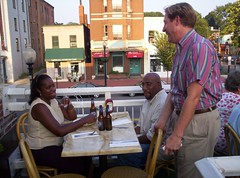ANCs build up political muscle, and yet....
 ANC6A Commissioner Gladys Mack, with a friend, and ANC6C Commissioner Bill Crews, at a reception for the Voice of the Hill community newspaper.
ANC6A Commissioner Gladys Mack, with a friend, and ANC6C Commissioner Bill Crews, at a reception for the Voice of the Hill community newspaper.Duncan Spencer's Hillscape column in the Congress-oriented The Hill newspaper talks about how active purposive Advisory Neighborhood Commissions and their Commissioners (each which represents a neighborhood district) make a positive difference in the city. He writes:
ANCs build up their political muscle
The city’s 37 advisory neighborhood commissions (ANCs) — the closest thing the city has to ward aldermen (and women) — are out of session. Sensibly, the local boards, peopled by D.C.’s first tier politicos, take the whole summer off. But the hiatus gives a chance to note the emergence of the ANCs — particularly here on the Hill, as a powerful force to reflect neighborhood direction and neighborhood consensus.
The ANC system came out of the city’s long yearning for home rule and saw its first election in February 1976. It was designed to provide nonpartisan, grassroots elected government by creating one district for every 2,000 residents, 299 districts in all, geographically spread among 37 commissions. But it soon became a steppingstone to higher office — two of the best-known city councilmen, for example — David Catania (I-At large) and Jack Evans (D-Ward 2) were once commissioners. “To provide community-based input to the urban policy-making process,” is how Catania describes the ANC mission.
The fact is that gentrification has greatly increased the power and persuasiveness of the ANCs. While two decades ago I wrote about sleepy evening ANC meetings with the radiator hissing while someone complained about crosswalks or neighbors squabbled over property lines, ANC actions in recent years have set the agenda for neighborhoods — stopping or slowing street alcoholism, enforcing license laws, limiting building alterations, exacting planning promises from downtown, altering parking patterns, promoting business districts and, most important, demanding attention from City Hall. The two Capitol Hill ANCs that most exemplify the new activist mode are 6A (Northeast) and 6B (Southeast), led (among others) by Joe Fengler and Cody Rice (6A) and Scott Cernich and Kenan Jarboe (6B). For this time of unusual change, they have become the forum and the policy police force of the community.
____________________
I think the two ANCs he calls out, ANC6A and ANC6B show the opportunity, as well as the challenge to accomplish more than just piecemeal change in a neighborhood, rather than contribute to structural improvements across the city.
For one, I think that (at least from what I read), ANC6A is much more oriented to urban design principles (such as those based on the work of Jane Jacobs Death and Life of the Great American City) while judging from the statements of people like Ken Jarboe, ANC6B is still enthralled by the automobile, parking, and more short-term thinking oriented--such as Jarboe's statement that a bridge extending Massachusetts Avenue SE across the Anacostia River would merely add another commuter road. This shouldn't be a surprise as most Americans are "imprinted" by the dominant suburban development paradigm of automobility, single-use zoning, and low density development. Why should ANC commissioners, for the most part people originally from someplace else, be any different.
ANC6A and ANC6C have been effective in working together concerning the revitalization of H Street, and both ANCs tend to be more pro-urban- and pedestrian-design focused than the average ANC. But it helps that neighborhood associations cross ANC boundaries, and neighborhood email lists share postings and listings from both ANCs.
However, ANCs are only as effective as the knowledge base of the Commissioners and those constituents who chose to participate in the ANC committees (if they exist--ANC6D just added committees after years of not having any).
The two biggest problems are:
1. ANCs are discouraged from meeting together (the original bill called for an ANC Assembly which apparently was scotched because City Councilmembers were worried that such an Assembly could provide a forum for potential challengers). This makes it hard to transfer learning and practices and develop best practices that can be further applied to other settings across the city. (E.g., at least 3-5 ANCs weigh in on what could be considered "Downtown" yet the planning-zoning committees never talk to each other). And
2. The learning and training infrastructure to support informed decision-making just isn't there. There is an Office of the ANC which provides some support to ANCs on capacity building, but there is little in the way of training provided by the various agencies on the issues that come before ANCs--such as zoning, planning, public space, transportation, alcoholic beverage licensing, etc.
Because Washington has so many professionals, some ANCs have members that are quite knowledgeable, but many do not.
And all too frequently it shows.
Lately, too, the "great weight" principle afforded to ANCs is being abused, maybe not in Ward 6 but in other parts of the city. E.g., ANCs voting against proposals not even submitted to District agencies, and making decisions without a careful consideration of the issues at hand. It really is a demonstration about one of the greatest weaknesses of participatory democracy, that is a dearth of informed representatives and an unwillingness to invest time and energy in learning about the issues.
The training infrastructure provided by the Neighborhood Revitalization Planning program in Minneapolis, or the Urban Information Center at the Dallas Public Library are best practices examples that could be adopted in DC to help make ANCs truly a powerful agent for neighborhood improvement. It wouldn't hurt if ANCs subscribed to publications like the Planning Commissioners Journal or had discounted memberships in the American Planning Association--offered to members of planning commissions, so ANC members would qualify--"Planning Board Member (planning official, commissioner or elected official, and do not earn my living in the field of planning)".



0 Comments:
Post a Comment
<< Home